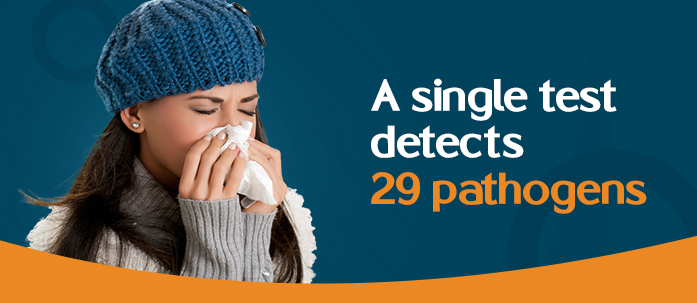Hurray…! Winter is here. Everyone likes the warm fuzzy feeling of curling up in a blanket, feeling the warmth of the winter sun, and having a good time with loved ones at the campfire. On the other hand, the winter season creates the fear of being sick, more often than not, and we don’t know what are the reasons behind it. Most of us experience a common cold, stuffy nose, sore throat, fever, cold sweats, headache, and exhaustion due to respiratory pathogens attacks. However, bacterial and viral infections can cause similar symptoms. Ideally, symptoms last for 5 to 7 days but sometimes they persist longer than a 10 to 14 days period. So it is crucial to diagnose what type of infection is encountered and to use the right medication. Misdiagnosed illness ends up in the wrong treatment and does not cure generally. Yoda provides a one-test solution to ensure that effective diagnosis reaches you, aids in preventing infections, and particularly reduces the incorrect use of the antimicrobial drug.
In winter, why are you more likely to get sick?
Respiratory pathogens include either bacteria or viruses which cause illnesses in our bodies. Many types of bacteria and viruses can infect the respiratory tract – the nose, sinuses, throat, and lungs. The nose is the primary point of contact with the external environment. The mucus glycoproteins present in nose cells detect the pathogens and destroy them, avoiding the pathogen attack before they get too far into the body. Though this mechanism happens every time, respiratory pathogen infections are especially high in winter. Since a protective response against pathogens is inhibited in colder temperatures, an infection attack is more likely to occur. Research suggests that the immune cells are more sluggish in cold temperatures than the warm temperatures. This is why the cold and flu rate increases in the winter every year, and why COVID-19 cases spike up in late fall and early winter of 2020.
Are antibiotics not improving your condition?
Antibiotics are important drugs that prevent the spread of bacterial infections successfully. But nowadays some typical antibiotics do not work as they used to. This implies that some bacterial strains develop the ability to defeat the drugs designed to kill them; those bacteria are said to be antibiotic-resistant. Overuse and misuse of antibiotics are the key factors behind the resistance to antibiotic drugs. The same goes for a viral infection. The prolonged use of antiviral drugs is one of the key factors in developing antiviral resistance. Antibiotic and antiviral resistance are together termed antimicrobial resistance. Using antibiotics for viral infection offers no relief.
What happens if there is an increase in antibacterial resistance?
According to the ICMR report, “The resistance level is increasing 5 to 10% every year for broad-spectrum antimicrobials, which are highly misused.
What WHO says?
- Antibiotic resistance leads to higher medical costs, prolonged hospital stays, and increased mortality.
- The world urgently needs to change the way it prescribes and uses antibiotics.
- Even if new medicines are developed, without behavior change, antibiotic resistance will remain a major threat.
Are you misusing antibiotics?
Antibiotics are essential to take in the right way. Suppose you ate antibiotics for 3 days instead of having 6 days as the doctor prescribed. Stopping medication in the mid-course might show a disappearance in symptoms but the pathogens are not completely eliminated from the body thus causing resistance to that antibiotic. So it is important to complete the course of treatment as per the instructions of the physician.
It is crucial to have the right medicine to heal the infection. Let’s understand a small analogy. Sugar and salt look similar but are entitled to their own taste. Using salt instead of sugar creates an insipid taste. Likewise, having similar symptoms of bacterial and viral infection need an appropriate diagnosis to treat the infection with the correct medicine and avoid misuse of antibiotics. To counter this, avail our unique Yoda Respiratory Pathogen panel that covers 29 different pathogens.
What is the Respiratory Pathogen panel?
Generally, bacterial and viral tests for respiratory infections are often limited to testing for one specific pathogen. Several individual tests should be conducted to rule out infection. This procedure can be difficult and time-consuming.
The Respiratory Pathogen panel needs only one sample to run the test for a wide variety of viruses (14) and bacterial (15) infections that cover 29 different pathogens in a single test, including the COVID-19 viral test using the Multiplex RT-PCR method. In a few days, a test report will be available, ensuring you get an early start on the right treatment.
What happens during the Respiratory Pathogen Panel?
There are two ways to collect the sample for test:
Nasopharyngeal Swab:
- You will bend your head back
- Your healthcare provider will insert the swab into the nostril until it reaches the top of the throat
- Your provider will rotate the swab and collect
Tracheal Aspirate:
Your provider will inject a saline solution into one of your nostrils, then remove the sample with gentle suction.
Yoda suggests
Each of us is more likely to get sick in cold temperatures rather than in warm temperatures for several reasons. Especially healthcare workers, pregnant women, and people with chronic health conditions. If you or your family members show any of the symptoms as discussed. Consult your doctor to stop struggling with infection for a longer period and get the right diagnosis as soon as possible.
Yoda Respiratory Pathogen Panel introduces the fastest way to identify and treat the infection with the correct medication. Along with this we also offer other respiratory pathogen tests but are limited to testing for specific pathogens. We hope to help you in making the right medical choices. Refer to (YODA LINK) to book the test.
























